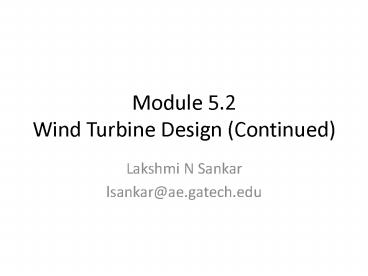Module 5.2 Wind Turbine Design (Continued) - PowerPoint PPT Presentation
1 / 13
Title:
Module 5.2 Wind Turbine Design (Continued)
Description:
Module 5.2 Wind Turbine Design (Continued) Lakshmi N Sankar lsankar_at_ae.gatech.edu OVERVIEW In Module 5.1, we gave preliminary comments about rotor design. – PowerPoint PPT presentation
Number of Views:40
Avg rating:3.0/5.0
Title: Module 5.2 Wind Turbine Design (Continued)
1
Module 5.2Wind Turbine Design (Continued)
- Lakshmi N Sankar
- lsankar_at_ae.gatech.edu
2
OVERVIEW
- In Module 5.1, we gave preliminary comments about
rotor design. - We reviewed the possible approaches to rotor
design (parametric sweep, optimization, inverse
design, genetic algorithm). - These may be combined.
- For example, a response surface (or a carpet
plot) of the power production as a function of
design variables may be curve fitted, and
searched for an optimum combination. - While increasing the rotor radius is a good way
of increasing power (since power varies as swept
area) this greatly increases the weight and
ultimately the cost of the system. - Other parameters should also be optimized.
- In Module 5.1, we also looked at some available
airfoils and their characteristics.
3
Selection of Planform
- Once the airfoils are chosen, and the best lift
coefficient (yielding highest Cl/Cd)at which the
airfoil will operate are known, we can determine
how chord c should vary with r. - The idea is to set the axial induction factor to
be equal to 1/3 equal to the Betz limit- from
root to tip. - This value of induction factor yields the highest
possible power from actuator disk model studies
in Module 2. - Optimum planforms are possible for a given tip
speed ratio, but not for all tip speed ratios.
4
Recall Thrust Produced by an Annulus of the Rotor
Disk
Area 2prdr Mass flow rate 2prr(U8
-v)dr Change in induced velocity 2v Thrust
produced over this annulus dT dT (Mass flow
rate) (2v, i.e. Twice the induced
velocity at the annulus) 4prr(U8
-v)vdr dT 4prr U82(1-a)adr (1)
dr
r
5
Blade Elements Captured by the Annulus
Thrust generated by these blade elements
dr
Some blade sections near the root and tip may not
behave like 2-D sections. This is due to a loss
of lift as pressure Tends to equalize between
upper and lower sides of the rot and tip. We
correct this with a loss factor F
r
6
Optimum variation of Chord with r
- Equate 1 and 2 (neglecting drag effects, which
are small)
small
7
Optimal Variation of Chord vs r
Local solidity
8
Variation of Chord with r for Optimum Rotors
- The previous slide states that chord should vary
as 1/r , large near the root and small near the
tip. - In practice, linear tapered blades are easier to
manufacture. - The design variables root and tip chord- are
parametrically varied, with a linear taper, to
find optimum combinations.
9
Optimum Number of Blades
- In the previous derivation of optimum variation
of chord with radius, Bc/pR is a non-dimensional
combination, where B is the number of blades. - This quantity is called local solidity.
- If solidity is high, Cl can be low and the rotor
can operate away from stall. - On the other hand, if solidity is too high,
blades are subject to extreme wind loads. - This equation says we can have a large number of
blades (B) with small c, or vice versa. - In practice fewer number of blades (2 or 3 at
most) with a large chord is preferred, both from
a cost and strength perspective - Blades and appendages are costly!)
- Larger chord, implies thicker blades that are
structurally stronger.
10
Optimum Variation of Twist with r
Twist
Angle of attack For best L/D
11
Selection of Tip Speed Ratio
- Best tip speed ratio WR/U? may be found by a
parametric sweep, using a computer code such as
WT_PERF or a spreadsheet based analysis. - Initially, as tip speed increases, for a fixed
wind speed, f increases increasing the propulsive
force. - Power increases, but optimum induced velocity has
not been realized yet. Efficiency is low. - As tip speed further rises, efficiency rises and
peaks. - At higher tip speeds, the airfoil sections begin
to operate at non-optimum angles of attack, and
propulsive force decreases. - Power decreases.
12
Variation of Power Coefficient with Tip Speed
Ratio for a Representative RotorNREL Phase VI
RotorRecall 16/27 is the maximum Power
Coefficient (Betz Limit)
13
In summary..
- Keep number of blades small (2 or 3).
- Keep solidity sufficiently high to avoid stall,
but small enough to avoid extreme airloads as
well. - Use linear taper ratio for simplicity in
manufacturing. - Consider nonlinear twist to keep induction factor
close to 1/3 over most of the rotor. - Nonlinear twist is easily accommodated in modern
wind turbines. - Operate, if possible, at optimum speed ratios
where power production peaks.































